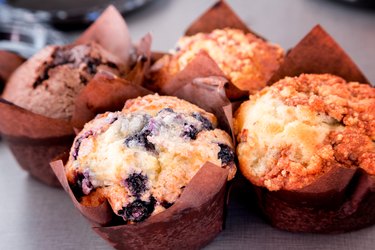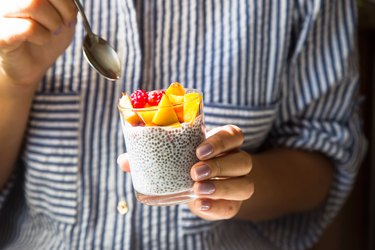
One popular weight-loss strategy involves cutting out processed foods. While simple in theory, this diet is typically easier said than done. Fortunately, there may be a more effective approach that doesn't require you to cut out an entire genre of foods.
The truth is, some processed foods are good for you and can actually help you lose weight. They can make your life a whole lot easier, too, and save you loads of time in the kitchen.
Video of the Day
Video of the Day
"'Processed foods' has become a buzzword term, and it's unfortunate because it gives a lot of healthy foods a bad rap," says Bonnie Taub-Dix, RDN, dietitian, creator of BetterThanDieting.com and author of Read It Before You Eat It — Taking You from Label to Table.
"So many people say they avoid 'processed foods,' but I don't think they really understand what that means, otherwise they'd be walking around eating a stalk of wheat instead of a slice of whole-grain bread," Taub-Dix says. "Even if you buy carrots from the store, if you bring them home and peel and steam them, that's processing."
So what is processed food, then? The catch here is that there's a difference between "minimally processed" and "ultra-processed" foods. All of these foods have been processed in some way, but it's the degree to which they've been manipulated that varies.
Minimally processed foods are packaged or lightly treated to preserve freshness and safety (think: milk and nuts), according to the Harvard T.H. Chan School of Public Health.
Ultra-processed foods, on the other hand, include additives, usually at the expense of nutrition.
"These ingredients may be starches, fats and added sugars," says Frances Largeman-Roth, RDN, nutrition expert and author of the upcoming book Everyday Snack Tray. "Ultra-processed foods will also include added salt, flavoring, coloring, gums and stabilizers. Examples include packaged cookies, crackers and other snacks, fast food and frozen meals."
The reality is, almost 60 percent of our diet is made up of ultra-processed foods, according to the American Institute of Cancer Research — about 1,200 of our daily calories come from these typically nutrient-void foods. Minimally processed foods like bagged spinach and pistachios only make up about 30 percent — or 600 calories — of our daily intake.
Why does this matter? Research shows that when we eat ultra-processed foods, we tend to eat more, whether or not that's the intention. Put another way, we naturally eat less when we eat a more minimally processed diet.
A clinical study May 2019 in Cell Metabolism evaluated the impact an ultra-processed diet has on weight compared to a minimally processed diet.
People either ate an ultra-processed diet with foods like a breakfast sandwich, strawberry yogurt, diet lemonade and canned beef and bean chili or a minimally processed diet of foods like oatmeal with blueberries and almonds, salad with chicken breast and farro and beef tender roast with couscous and green beans.
The researchers found that after just two weeks, the ultra-processed group gained about two pounds while the minimally processed group lost about two pounds. The latter naturally ate about 500 fewer calories per day.
With the distinction between minimally and ultra-processed goods in mind, here are the ingredients that can support weight loss, along with the processed foods to avoid while pursuing weight loss.
5 Processed Foods That Can Help You Lose Weight

Cutting out processed foods entirely isn't necessary for shedding pounds. But which minimally processed foods can help with weight loss? The goods news is, there are many options and they typically cost less than their more highly-processed counterparts.
1. Plain Yogurt
A cup of plain, low-fat yogurt has 150 calories and 13 grams of protein, according to the USDA. The same serving of plain Greek yogurt has almost twice the protein at 24 grams.
Protein is the most satiating nutrient, according to a July 2016 article in Annual Review of Nutrition. Having adequate protein at a meal can help you feel fuller longer.
The key here is opting for plain yogurt, which means it's free of added sugars. Some, if not most, flavored yogurts are high in added sugars, which add calories without any nutritional benefits.
Tip
If you don't love the taste of plain yogurt, try adding berries, nuts and spices like cinnamon for a flavor kick.
2. Oatmeal
Minimally processed oats and other whole grains are a must-have when it comes to weight-loss diets. Whole grains are a good source of soluble fiber, which can help maintain your weight, as well as reduce the risk of diabetes, heart disease and certain cancers, according to the Mayo Clinic.
Oats specifically have a unique compound called beta-glucan. Research suggests that beta-glucan suppresses our appetite and increases our satiety, per a August 2018 paper in Appetite.
3. Nuts
Don't skip out on nuts just because you can find them in the snack aisle alongside less-nutritious foods or because they're high in fat. Nuts like pistachios, walnuts and almonds can actually be an effective part of your weight-loss plan.
A September 2019 study in BMJ Nutrition, Prevention & Health suggests that eating nuts may actually help prevent us from gaining weight as we age and decrease our overall risk of having obesity. The results were found with eating just a half-serving of nuts (about half an ounce) per day.
4. Canned Beans
Buying dried beans may be less expensive, but canned beans will save you time (as in a couple of hours) and they're just as nutritious. If you prefer dried beans, have at it — but if you're buying them to avoid extra processing, there's no need.
Beans, in general, are great for weight management because they're satiating and contain fiber that slows digestion, which can stimulate the hormones in your gut and tell your brain you've had enough to eat.
In fact, a May 2016 meta-analysis in the American Journal of Clinical Nutrition found that after just six weeks, adding beans and other legumes to the diet resulted in a significant reduction in weight compared to diets without beans.
5. Popcorn
Popcorn is a nutritious, minimally processed snack, says Largeman-Roth.
This whole-grain food can aid in weight loss thanks to it's high fiber content and low calorie density, according to the American Heart Association. What's more, it's been linked to a lower risk for conditions like diabetes and heart disease.
Just make sure to pick air-popped, lightly seasoned versions of the snack without added butter instead of options with excessive sodium or sugar.
5 Processed Foods That Can Hinder Weight Loss

Cutting out certain processed foods can be beneficial you're trying to lose weight. Here are the ultra-processed foods to avoid during weight loss:
1. Sugary Beverages
Sugar-sweetened beverages are the number-one source of added sugar in American diets, according to the Centers for Disease Control and Prevention. As you can imagine, this isn't great for your weight-loss goals or overall health.
Regularly drinking sugary beverages like soda, energy drinks, fruity drinks and coffee loaded with sugar is associated with weight gain and obesity, along with type 2 diabetes, heart disease, tooth decay, and kidney diseases.
Skip the sugar-laden sips and enjoy more nutritious drinks that can help you lose weight like green tea and sparkling water.
2. Fried Foods
Fried foods often start out as beneficial ingredients — like potatoes and chicken — that end up losing most of their nutritional value during the frying process. This doesn't even take into consideration the often-sugary dips you use with fried foods, like ketchup and barbecue sauce.
In fact, a February 2013 study in Nutrition, Metabolism and Cardiovascular Disease found that eating fried foods more than four times a week significantly increases our risk for having overweight or obesity compared to limiting fried food to less than twice a week.
3. Baked Goods
A muffin might sound healthier than a doughnut, but it's often higher in calories and can have just as much (if not more) added sugar. Baked goods are typically made with refined grains and added sugar, something you want to limit if you're trying to lose weight. Refined grains are low in fiber, a nutrient that helps to keep us feeling fuller longer.
A September 2019 study in the Journal of the American Medical Association looked at the diet of more than 40,000 adults and found that about 42 percent of our daily calories come from low-quality carbs like baked goods.
The researchers noted that while this number may have improved over the years, it's still too high.
4. Salty Snacks
We snack a lot in the U.S., and salty snacks rank number one when it comes to what we're noshing on between meals, according to a May 2016 paper in Advances in Nutrition.
Potato chips, crackers and pretzels are typically low in fiber and, depending on the snack, can be high in refined grains and/or loaded with fat and salt. These qualities, or the lack thereof, don't serve us when we're trying to lose weight.
Not all salty snacks are created equal, however. Nuts, for instance, are often found in the snack aisle, and when they're just roasted and salted they qualify as a good-for-you snack option and can help with weight management.
5. Frozen Meals
Even though frozen meals may appear to have certain nutritious ingredients, by and large, they contain highly processed additives like salt and flavoring, says Largeman-Roth.
Indeed, these quick meals are typically loaded with saturated fats, sodium, added sugars and refined grains, according to the Cleveland Clinic, all of which can hinder your weight-loss efforts.
Tips to Help You Pick the Right Processed Foods
Here are some pointers to help you decipher minimally processed foods from their ultra-processed counterparts.
1. Check the Ingredient List
If you're trying to eat less heavily processed foods, taking a look at a product's ingredient list can help.
For example, there are bars on the market with a beneficial balance of carbohydrates, fiber, fat and protein, along with almost 20 vitamins and minerals, which by the nutrition facts panel read like a healthy food.
But if you look at the ingredient list, you'll see items like fractioned palm kernel oil, maltitol, polydextrose, marshmallow, sugar and sucralose. If you just scan the nutrition facts panel and skip the ingredient list, you're not getting the full picture of what's actually in the bar, Taub-Dix says.
To determine if a food is ultra-processed, you really need to turn the package over and read the label. You might find an almond butter with added salt or added sugar, and you'd be better off in most cases choosing the almond butter with just almonds on its ingredient list.
But it's also not that black and white, Taub-Dix says. You have to look at the big picture, and at your whole day. If you like the almond butter with sugar and you find you don't need jelly, you're likely better off in the end. Ultimately, it's about finding balance in your diet.
Is Polydextrose Bad for You?
Polydextrose is an artificial sweetener and type of soluble fiber, according to the Harvard T.H. Chan School of Public Health. In moderation, polydextrose can actually support stool bulk and ease constipation.
2. Don't Be Afraid of Ingredients Just Because You Can’t Pronounce Them
"There's also a lot of mixed message out there in media like, 'If you can't pronounce an ingredient, you shouldn't eat it,' or 'Don't eat a food with more than five ingredients' — but those are scare tactics and quick soundbites," Taub-Dix says.
In some cases, the added ingredients are actually good for us. You might find ascorbic acid listed on the ingredient list and think it's a chemical, when in fact it's vitamin C.
"Or, for instance, I love Dave's Killer Bread and it has about 25 ingredients, but it's still a healthy, whole-grain bread with fiber and protein," Taub-Dix says. "If you don't know what an ingredient is, look it up. You should question and be informed, but don't miss out on nutritious food just because there's an ingredient you can't pronounce or there's more than five ingredients."
3. Learn the Other Names for Sugar and Salt
Added sugar and salt can be sneaky when it comes to the ingredient list because they go by many names.
"One thing to be aware of is that sugar is the master of aliases. There's high-fructose corn syrup, organic cane sugar and many more," Taub-Dix says.
Other common names for added sugar, according to the University of California San Francisco, include:
- Agave nectar
- Barley malt
- Beet sugar
- Cane juice
- Caramel
- Carob syrup
- Date sugar
- Fructose
- Invert sugar
- Maltodextrin
- Molasses
- Palm sugar
- Raw sugar
- Rice syrup
- Sorghum syrup
The amount of added sugars is also required to be listed on the nutrition facts panel.
The American Heart Association shares other monikers for salt, including:
- Disodium guanylate (GMP)
- Sodium bicarbonate
- Sodium nitrate
- Sodium citrate
- Sodium glutamate
- Sodium lactate
- Sodium phosphate
The sodium content will also appear on the nutrition facts panel, so make sure to read thoroughly before you buy.
4. Shop the Entire Supermarket
The old advice to "stick to the perimeter" is not only outdated, it's out of touch.
"Now, I love foods in the perimeter — the produce is my favorite — but we need to make the most of the middle too," Taub-Dix says. "If you skip the middle, you're missing out on so many nutritious foods like beans, pasta and almonds. Beans especially are nutrient-dense, they're inexpensive and easy to store."
The initial intention behind this shopping guidance was good because so many ultra-processed foods exist in the middle of the supermarket, but so do many nutritious, minimally processed and often less-expensive products.
The middle also often houses products that allow for shortcuts for busy families, like canned beans and vegetables, pre-cooked brown rice, frozen fruits and veggies and so on.
- American Institute of Cancer Research: "Processed Foods, Calories and Nutrients: Americans’ Alarming Diet"
- Cell Metabolism: "Ultra-Processed Diets Cause Excess Calorie Intake and Weight Gain: An Inpatient Randomized Controlled Trial of Ad Libitum Food Intake"
- MyFoodData: "Nutrition Comparison of Low-Fat Plain Greek Yogurt vs Low-Fat Yogurt"
- Annual Review of Nutrition: "The Macronutrients, Appetite, and Energy Intake"
- Appetite: "Effects of Oat B-glucan Consumption at Breakfast on Ad Libitum Eating, Appetite, Glycemia, Insulinemia and GLP-1 Concentrations in Healthy Subjects"
- Mayo Clinic: "Whole grains: Hearty Options for a Healthy Diet"
- BMJ Nutrition, Prevention & Health: "Changes in Nut Consumption Influence Long-term Weight Change in US Men and Women"
- American Journal of Clinical Nutrition: "Effects of Dietary Pulse Consumption on Body Weight: A Systematic Review and Meta-analysis of Randomized Controlled Trials"
- CDC: "Get the Facts: Sugar-Sweetened Beverages and Consumption"
- Nutrition, Metabolism and Cardiovascular Disease: "Consumption of Fried Foods and Weight Gain in a Mediterranean Cohort: The SUN Project"
- Journal of American Medical Association: "Trends in Dietary Carbohydrate, Protein, and Fat Intake and Diet Quality Among US Adults, 1999-2016"
- Advances in Nutrition: "What Is a Snack, Why Do We Snack, and How Can We Choose Better Snacks? A Review of the Definitions of Snacking, Motivations to Snack, Contributions to Dietary Intake, and Recommendations for Improvement"
- Harvard T.H. Chan School of Public Health: "Processed Foods and Health"
- Harvard T.H. Chan School of Public Health: "Fiber"
- University of California San Francisco: "Hidden in Plain Sight"
- American Heart Association: "21 INGREDIENTS (THAT MEAN SODIUM) TO WATCH ON THE LABEL"
- American Heart Association: "Popcorn as a snack: Healthy hit or dietary horror show?"
- Cleveland Clinic: "8 Ways to Find the Best Frozen Meals"

